Cleombrotus
The Biggest Spartan Loser
Jeff Jonas
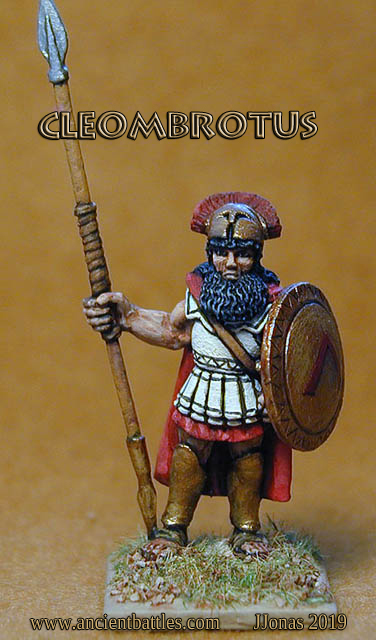
"Now our fine fellow will show whether he is really so partial to the Thebans as is alleged"
Cleombrotus was the 21st King of Sparta of the Agiadai side of Spartan Kings. This meant his lineage went back to the greatest King of Sparta, Leonidas, the legendary hero of Thermopylae. Cleombrotus ruled jointly with Agesileus of the Eurypontidai side of Spartan Kings. This idea of dual Kingship had worked for the Spartans going back hundreds of years. One benefit was that a young king on one side could often be offset by a mature King of the other, this way there was little transitional conflict, and no insidious regency's in Sparta. Cleambrotus came to the throne in 380 BC at time when Sparta dominated Greece by virtue of her victories over Athens in the Peloponnesian Wars, and recently after winning the bitter "Corinthian War. His conduct at the fateful battle of Leuctra in 371 BC led to the ultimate demise of the Spartan hegemony, and began the end of the idea of the superiority of Spartan military prowess. Over confident and possibly a bit drunk, Cleombrotus fell for the Theban general Epaminondas' tactics and the Thebans crushed the Spartans in open battle. Cleombrotus, like many hoplite generals died in the fight, so he missed out on the repercussions and lamentations his defeat set in motion.
Cleombrotus in 28mm
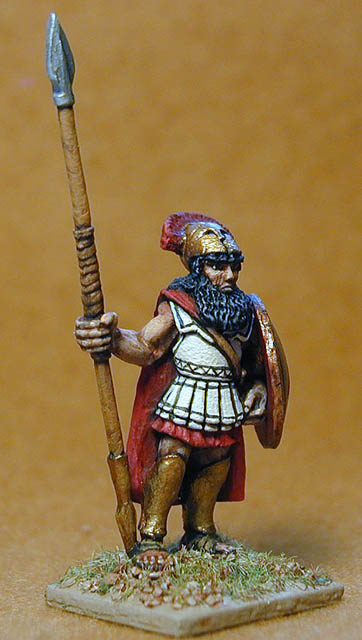
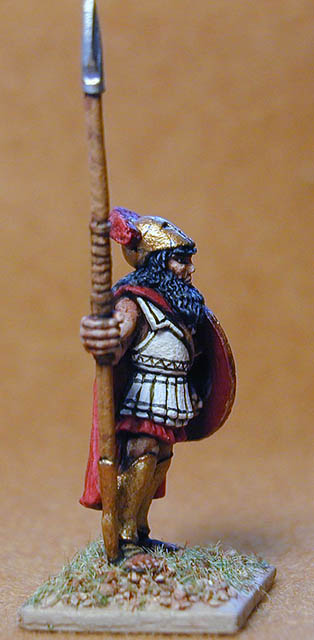
This is a 28mm model produced by Xyston miniatures. The
model is labeled Leonidas, but for a number of reasons I did not like
this figure as Leonidas (the hero of Thermopylae in 479BC). Leonidas
probably wore an earlier style of armor than this model. The Spartans
probably still wore the "Bronze Bell" or muscle cuirass at
Thermopylae, or at least a "Composite cuirass", not the later style
linen Tube and Yoke armor also known as linothorax of this
model.
You can see the Gorgon Studio version of Leonidas I like better here:
Leonidas
Because of this, I decided to paint this figure as if it was Cleombrotus the Spartan King who died at Leuctra.
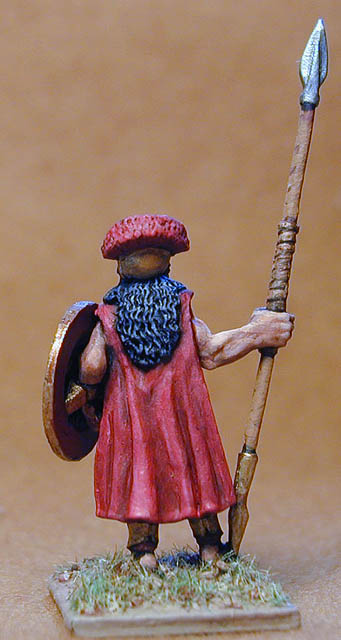
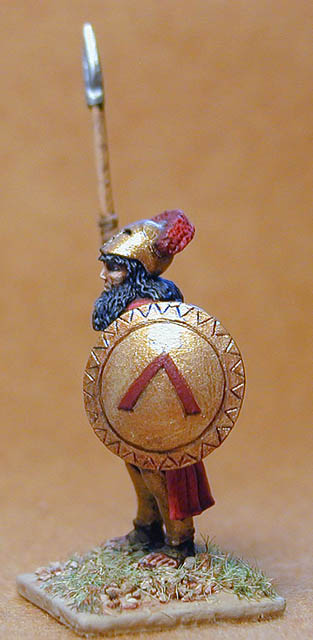
Cleombrotus wears the typical gear of a hoplite in the 4th century BC. He has "Tube and Yoke" linen or leather body armor (often referred to as linothorax), and the large hoplite shield, the aspis. He wears a small Corinthian style helmet with a transverse crest. Which is often shown in Spartan artwork (see page bottom). His spear is way too large for the figure scale, but has a lot of extra detail that normally is overlooked. For instance the hand grip is modeled, and the butt spike ("lizard-killer" or sauroter) is well defined. Because of these features I decided to leave the spear on, despite the cartoon-like oversized appearance. All the weapons on the Xyston 28mm figures are a bit chunky.
 |
The hoplite
spear (called a dory or doru) was about 2 to 3 m long, from the
butt spike to the blade tip (between six and nine feet). They were
made from Cornel or Ash wood. The long flat leaf-shaped spearhead
was iron and it was counterbalanced by an iron or more usually
bronze butt-spike called a sauroter ("lizard sticker"). This spike
could be used for planting the spear in the ground, or as another
point if the blade end shattered (a common occurrence in battle),
or even to dispatch fallen enemies wihout having to flip the spear
over. Here is a bronze sauroter with a dedication: https://harvardartmuseums.org/collections/object/304009 |
I painted the colors based on the standard notion of what the Spartans are assumed to have worn. A Scarlet Chiton is worn, as well as the Scarlet cloak. The armor is not overly decorated to fall into the "Spartan" theme. Basic bronze on the helmet and greaves. The very large bushy beard may be a bit of an anachronism here. Spartans are often depicted now with their upper lips shaved, but this is a style that may have gone by the wayside by this time... but since this is a King, he might be more inclined to appear as instructed by Lycurgus, the Spartan lawgiver.
Shield designs
Cleambrotus carries a Xyston cast shield. However the shield had a embossed lambda device sculpted on. Embossed shields are rare in Greece up to the time of Alexander the Great so I felt justified in carving it off. Also I hate embossed designs on shields (unless they were actually embossed). So what did I paint on the shield? A lambda of course! This was the Spartan symbol adopted (as Nick Sekunda surmises) because other good symbols were already being used by others. Letters had become a common symbol to identify troops in the long period of City-State wars. Athens used an A monogram. Other Peloponnesian cities adopted letters over more ornate devices as well. Sicyon and Elis being cited as well as other. The lamda is easy to paint, but one can buy transfers like the excellent LBMS ones above.
So this Xyston figure has some issues, but the end result is a striking model, that is worthy to lead a 28mm Spartan army of the 4th century.
More notes:
The
Corinthian war
was fought mostly by Agesilaus who was by any measure a military
genius, but eventually Sparta could not resolve the conflict without
giving away concessions to Persia. One of these concessions was
ceding all the Ionian Greeks back to Persia. During the war Argos
and Corinth formed a league and basically became a unified state.
Thebes also confederated with neighbors to create a stronger
Boeotian League.
A unified Spartan and Persian fleet threatened Athen's grain supplies and the Athenians gave up. The Peace of Antalcidas (387) was the result, but the Greeks called this the "King's Peace" because the terms were dictated by Artaxerxes, the Persian King.The Spartans forced the Corinthians and the Argives to de-federalize and also wished the Boeotians to break up their league. The Boeotians were less inclined to agree.
Seven years later Agesilaus was about 57 and he was now forced to invade Boeotia to impose the Peace. In 378 and 377 the Spartans ravaged Boeotia but could not force a battle. When the Spartans left, the Thebans expelled their garrisons. By 371 the Spartans were fed up with the situation in Boeotia and decided to send the younger King Cleombrotus (you knew I would get to him sooner or later) with 11,000 troops supported by more troops en route.
Cleombrotus met up with the Thebans at Leuctra (here is Xenophon's account). Xenophon tells us that Cleombrotus was apparently goaded on by those who felt hewas "soft on the Thebans", and also by those who remembered how the Thebans had escaped punishment in battle under Agesilaus. Cleambrotus himself did not seem to take the smaller Theban army very seriously as the morning meal and drinking had extended to noon.
Cleambrotus aligned his army in a crescent against the Boeotians, with his Spartans on the right and lesser allies arranged to the left. The Spartan phalanx was 12 deep. The Spartans knew that in a hoplite battle the lines would surge to the right, and as they approached the right wing would overlap the enemy's left flank. This had gained them victory at Nemea, and other battles in the past. At Nemea the Spartans edged so far to the right they needed to carry out a maneuver to then flank the whole enemy line in turn. Cleambrotus most likely expected a similar result this day, but he seems to have forgotten that at another battle in Boeotia at Koronea in 394. The Thebans there had put up a very stiff fight in a head to head fight, and Pelopidas and his Theban Sacred Band had bested Spartans in a pass recently. The Thebans had shown that they could stand and fight with the Spartan elites, and were tough opponents strengthened by the gymnasium or by the labors of farm work.
The battle kicked off with an odd outflanking move as Spartan allies attacked a column of refugees from the Theban camp and drove them back,pressing them back towards Epaminondas' army. The Thebans do not seem to have been overly affected by this commotion, and formed their phalanx on the left of their line, 50 ranks deep, the rest of the army was in echelon, refusing their right wing (see Epaminondas).
The Theban cavalry was operating in front of their phalanx, and for some reason Cleambrotus sent out his cavalry in front as well. Xenophon describes the Spartan cavalry as second line troops, riding horses provided by the richest Spartans . Once the battle lines began to move the seasoned Theban cavalry quickly routed the Spartan horse. The fleeing horsemen fled back through their phalanx, disrupting their advance, and stirring up the summer dust.
Cleambrotus pressed forward with the Spartans ahead of the rest of his disordered army, and crashed headlong into a massive column of Thebans operating in a phalanx 50 deep. The column was pushed back but the Spartans were taking heavy losses as the Thebans resisted rather than flee (as phalanxes would often flee when faced by Spartans in the past before coming to blows). Out of the dust the 300 members of the Theban Sacred Band then slammed into the flank of the Spartans. Cleambrotus fell mortally wounded. The Spartans surged forward and pulled him back as he died. A Spartan Polemarch and other high ranking men fell, and then the dust and the routing cavalry and the loss of their King made them recoil under the Theban pressure. The left wing of the Spartans may have not yet engaged the Boeotians but fell back in shock when they saw the unbeatable Spartans retreating. Then the whole line broke and ran back to the trench around their camp.
The Spartan army rallied and debated whether they should continue the fight, but the they were in shock to realize that 400 of the 700 elite Spartiates had been killed, along with 600 other Spartans. This was an unparalleled disaster for Spartan arms. They had lost battles before but never to a hoplite army in a stand up battle. The Spartans called a truce and negotiated for their dead and were expelled from Boeotia.
So Cleambrotus had invaded
Boeotia with a large force of unbeatable Spartans and allies, and fought
a smaller Theban army, and was beaten squarely.
The losses were unrecoverable and Sparta was never the same. The
hegemony they had earned for 50 years was blown away, and Thebes now was
calling the shots in Greece. Nobody would have bet on this in Vegas.
What were the odds? Cleambrotus goes down as the biggest loser in
Greek history, against a smaller army he ended up getting both
himself killed and Spartan invincibility shattered in one single battle.
He had succumbed to Epaminondas' plan to reverse the typical linear
hoplite battle and attack the Spartans head on, isolating them from the
rest of their allies, to keep them from turning the left wing of his
smaller army. Not only did the Thebans defeat the Spartans, but
they did so head to head, and with a smaller army, it was as if the
"world turned upside down", at that moment.
In 368 the Spartans mustered enough strength to fight the Arcadians. The Spartans charged and the Arcadians fled. They referred to this as the "Tearless battle" because no Spartan was killed. As Plutarch states "IIn earlier times, victory was so routine that there were no celebrations in Sparta even for the greatest successes. But now the Spartans greeted the returning soldiers, cheering and crying tears of joy, and thanking the gods for wiping away their disgrace. Up until that time, the Spartan men had been too ashamed to face their women."
But a few years later the Thebans beat a last gasp attempt of Sparta to come back, and the Spartans lost their claim as the greatest warriors in Greece. Agesilaus now over 80 years old left Sparta to become a mercenary captain in a Egyptian army. At the age of 85 he died while sailing back home, the last King of Sparta to remember victory as a routine occurrence.

Questions or Comments Email:
Where do you want to go next? Click on: Site Map
Back to AncientBattles.Com Home Page
04/28/07